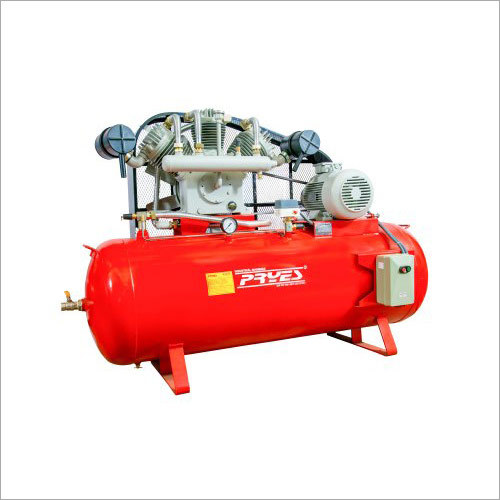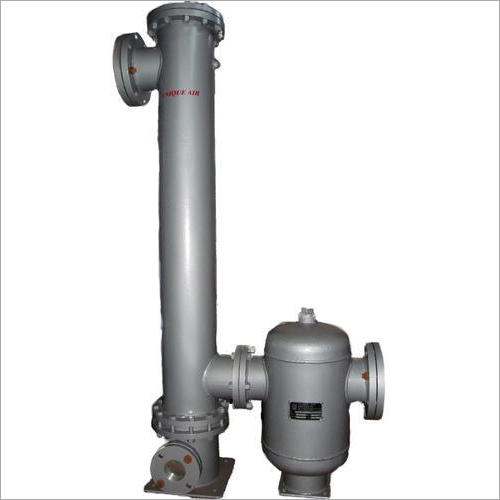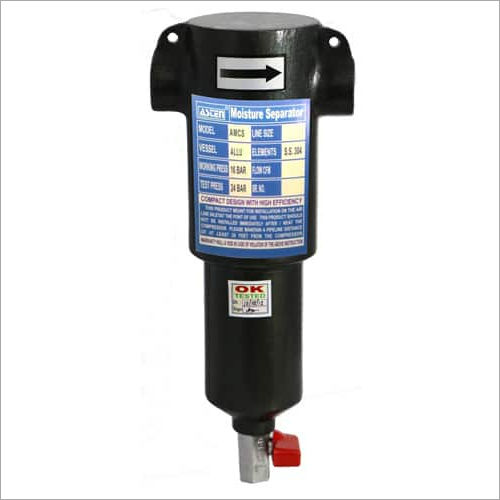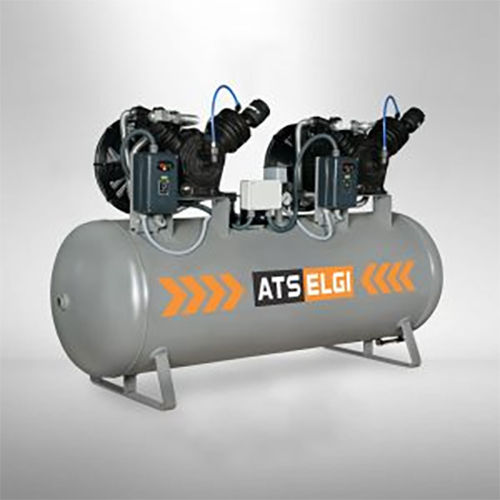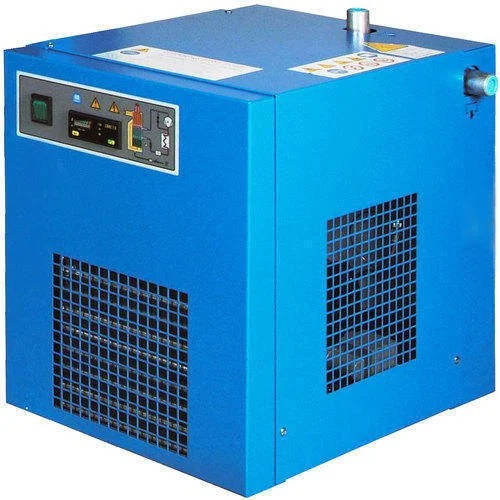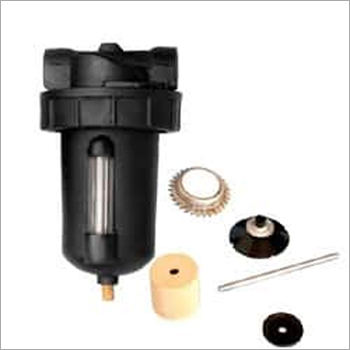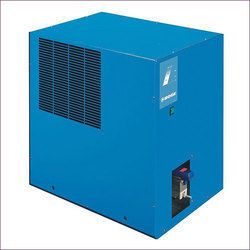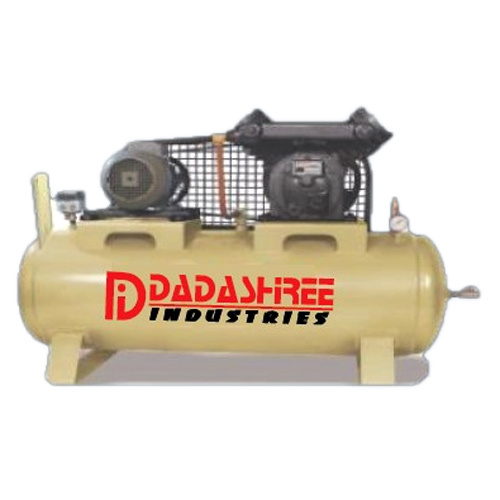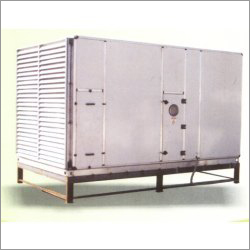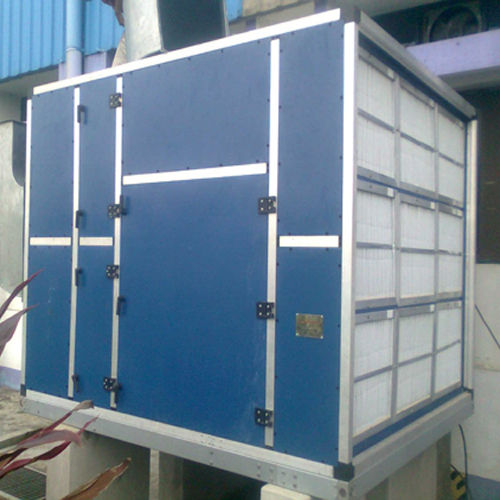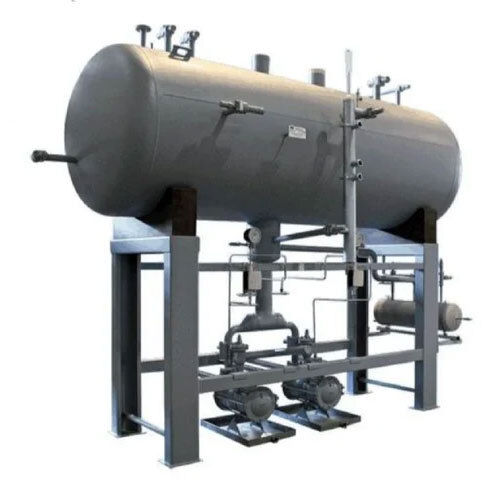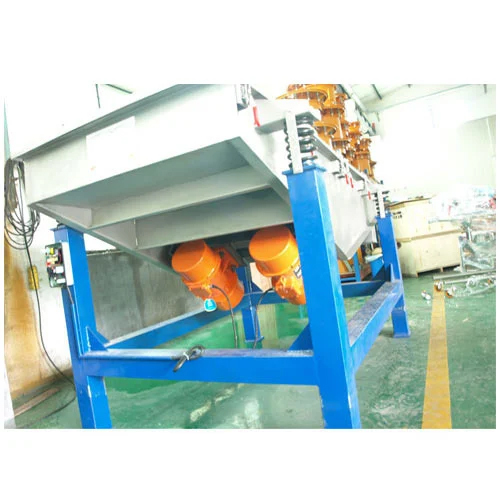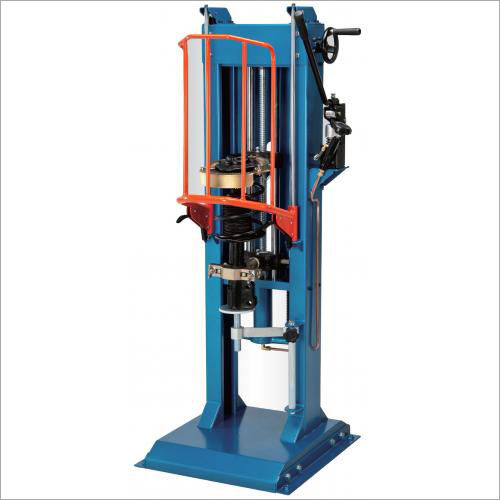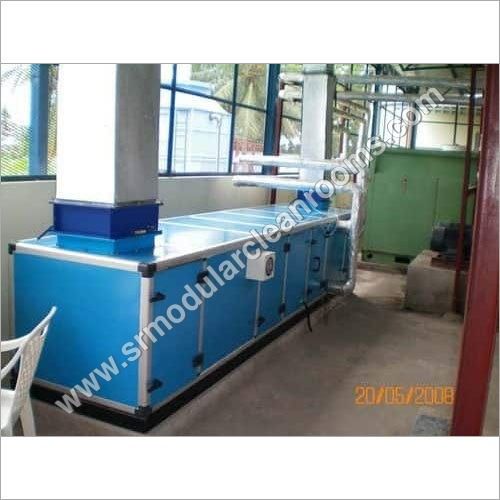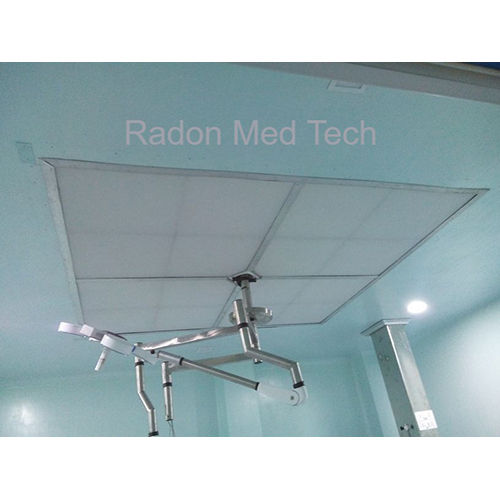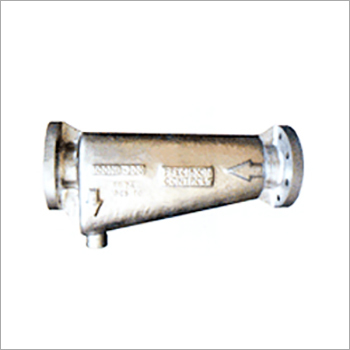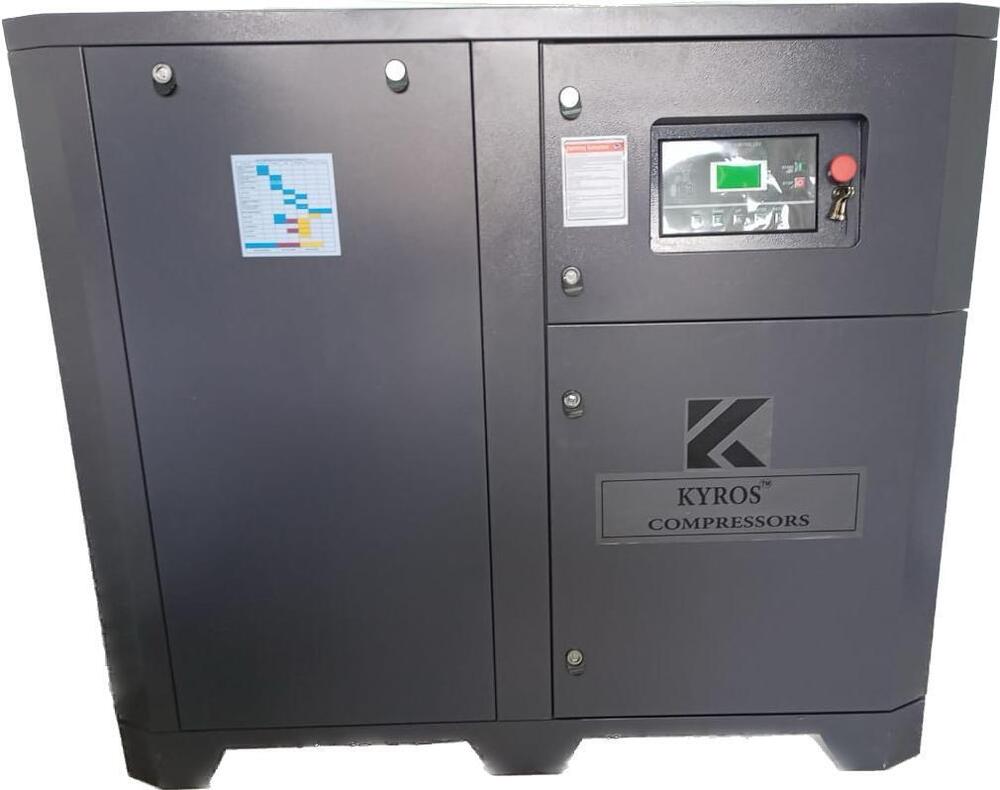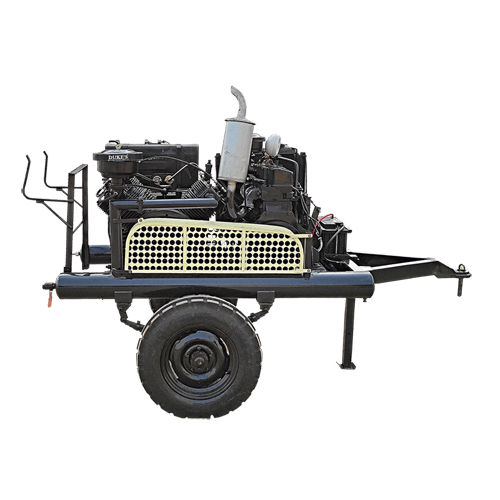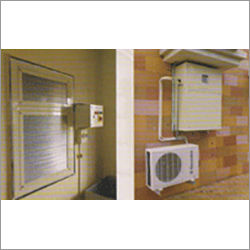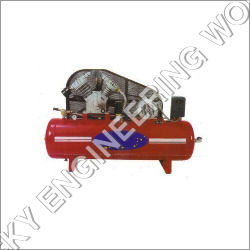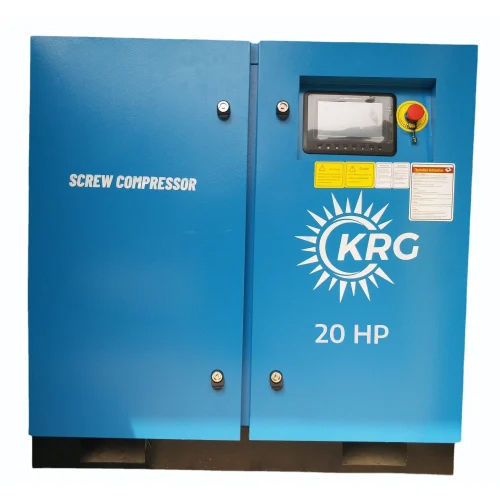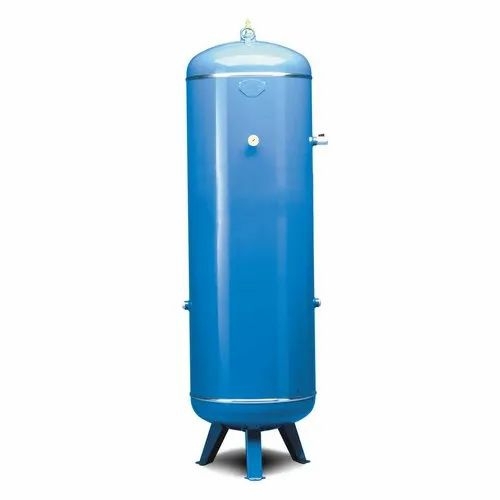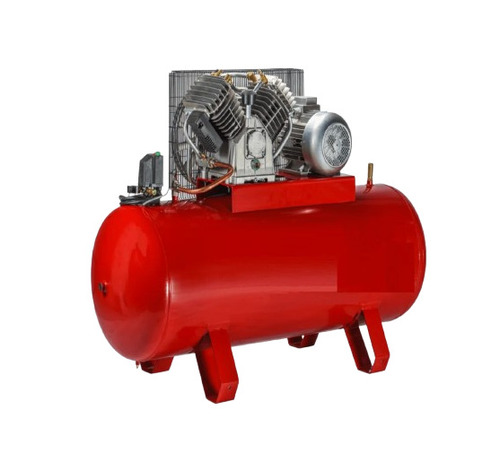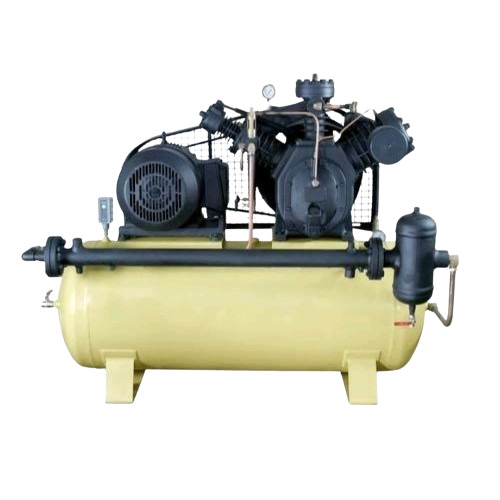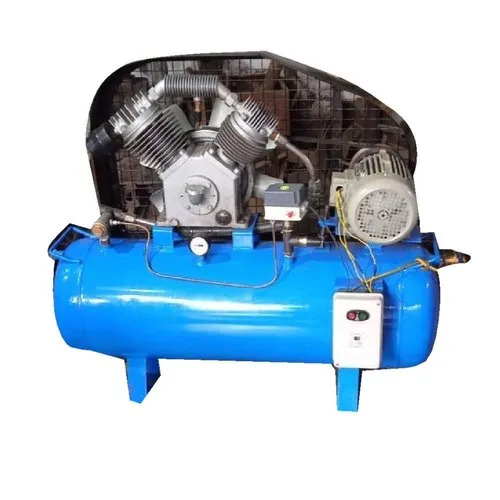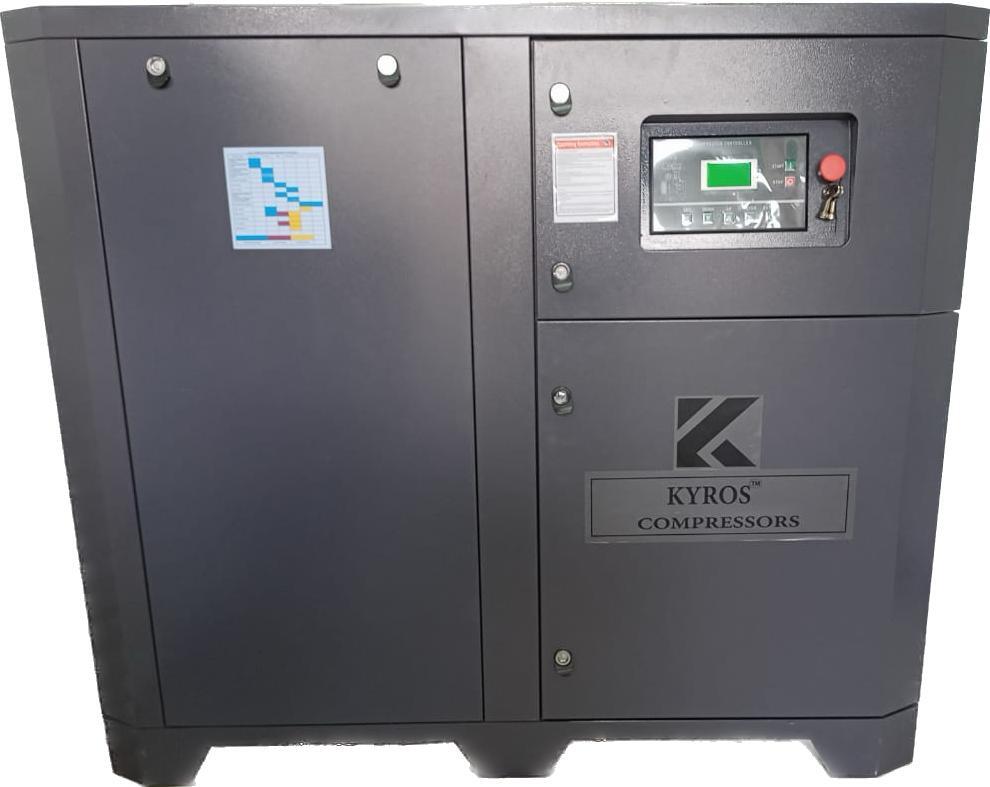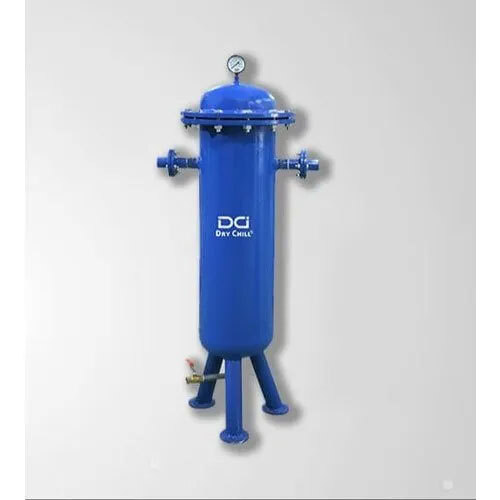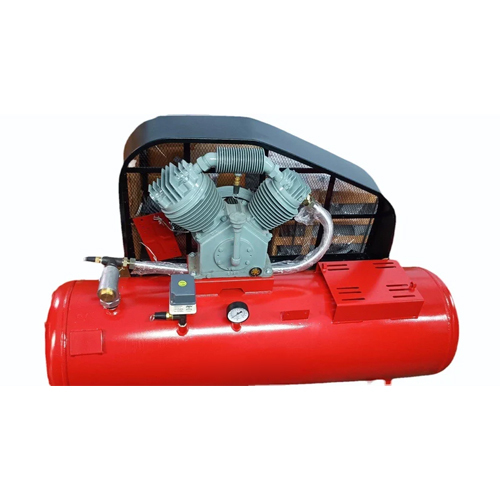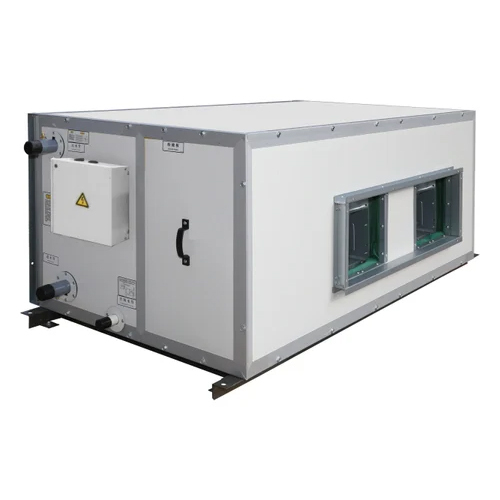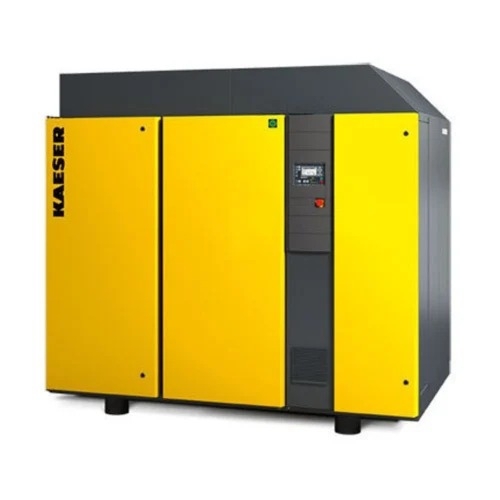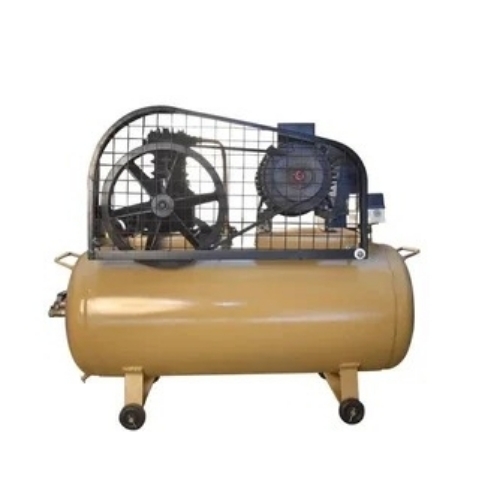Air Compressors & Air Separation Plants
(4373 products)15 Hp Reciprocating Air Compressor Air Flow Capacity: 45 Cubic Feet Per Minute (Ft3/Min)
Price Trend: 161200-181350 INR/Piece
MOQ1 Piece/Pieces
Product TypePISTON OR RECIPROCATING AIR COMPRESSOR
UsageCNC Industry, Chemical Industry, Food Industry, Textile Industry
Noise Level72 db
Power Consumption24 Ampere
ColorRED,SILKY SILVER,BLUE
Weight525 Kilograms (kg)
Robust Air Receiver Vessel
Product DescriptionCapitalizing on the adeptness of our experienced workforce, we are involved in manufacturing, exporting and supplying an extensive gamut of Robust Air Receiver Vessel in Mumbai, Maharashtra, India. These vessels are manufactured by utilizing supreme quality raw materials and are examined at every st
Moisture Separator - Color: Grey
Price: 65000 INR/Piece
MOQ1 , Piece/Pieces
ColorGrey
UsageIndustrial
ConditionNew
Power SourceElectric
Lubrication TypeLubricated
Warranty1 Year
Foam Chambers
FOB PortJNPT NHAVA SHEWA
Supply Ability50 Per Month
Packaging DetailsExport Quality Packaging
Aluminum Moisture Separator - 1/2 to 6 Inch Size | Brass Ball Valve
Price: 1850 INR/Piece
MOQ1 Piece/Pieces
Size1/2 to 6 Inch
Product TypeMoisture Separator
PowerUpto 10 Bar Siemens Volt (S )
ConditionNew
MaterialMild Steel, Stainless Steel
Power SourceElectric
Grey Air Compressor
MOQ1 Unit/Units
ColorGrey
Product TypeAIR COMPRESSOR
UsageSpray painting. Pneumatic tools. Motor Cycle Shop. Automotive garages work shop. Tyre shop PV/CV. Wash Stations.
ConditionNew
Ats Elgi Limited
Coimbatore
 Trusted Seller
Trusted Seller3 Years
Vertical Water Screw Air Compressor Capacity: 270 Liter/Day
Price: 300000 INR/Set
MOQ1 Set/Sets
Colorother
Product TypeVertical water-cooled air compressor
MaterialOther, Stainless steel
TypeBroaching, Drilling, Milling, Turning, Chemical Machining, Other, Laser Machining, Etching
Capacity270 Liter/day
ComputerizedYes
Labh Projects Pvt. Ltd.
Ahmedabad
 Super Seller
Super Seller4 Years
Compressed Air Dryer - Refrigerated Technology, 2 HP Motor, 220/415 V Power Supply, Blue Color, 12 Months Warranty | Automatic Operation, Industrial Usage
Price: 110000 INR/Piece
MOQ1 Piece/Pieces
ColorBlue
Product TypeCompressed Air Dryer
UsageIndustrial
ConditionNew
Power Source220/415 V
Voltage220/440 V Volt (v)
Emtex Machinery Private Limited
New Delhi
Mild Steel Double Skin Air Handling Unit
Price Trend: 175000.00 - 800000.00 INR/Unit
MOQ01 Unit/Units
UsageIndustrial
Product TypeAir Handling Units
ConditionNew
MaterialMild steel
Moisture Separators - High-Efficiency Aluminum , Compact Design for Optimal Water Removal
MOQ10 Unit/Units
Payment TermsTelegraphic Transfer (T/T), Cash in Advance (CID), Cheque, Cash Advance (CA)
Supply AbilityAs per client requirement Per Day
Sample AvailableYes
Refrigerated Air Drying Unit - Stainless Steel, 54.62 kg | High Efficiency Microprocessor Control, Moisture-Free Compressed Air, Large Condensers
Price Trend: 20000.00 - 200000.00 INR/Piece
MOQ1 Piece/Pieces
UsageFor reduce the temperature of compressed air through contact with a cold medium
Product TypeRefrigerator
MaterialStainless Steel
Weight54. 62 Kilograms (kg)
ColorBlue
Dry Vacuum Pump - Material: Cast Iron
Price: 550000 INR/Unit
MOQ1 Unit/Units
Product TypeVacuum Pump compressor
Power Consumption3 Horsepower (HP)
UsageIndustrial
ConditionNew
MaterialCast Iron
PowerElectric
Clean Air Handling Unit - Automatic Grade: Full Automatic
Price: 200000 INR/Piece
MOQ10 Piece/Pieces
SizeStandard
DustDry Dust
UsageIndustrial
Humidity %80-90%
ColorGrey
ConditionNew
Industrial Air Handling Units - Mild Steel, Different Sizes Available, Sleek Blue Color, 220-440 Volt Usage
MOQ1 Unit/Units
SizeDifferent Size
ColorBlue
Product TypeIndustrial Air Handling Units
UsageIndustrial
ConditionNew
MaterialMild Steel
Filtotech Air Control System Private Limited
Kolkata
Black Low Pressure Ammonia Receiver
Price: 900000 INR/Piece
MOQ1 Piece/Pieces
UsageIndustrial
ColorBlack
Product TypeLow Pressure Ammonia Receiver
ConditionNew
Warranty1 YEAR
Goldin (india) Equipment Pvt. Ltd.
Vadodara
126 Kg Shock Absorbers Spring Compressor - Color: Blue
Price: 148504.62 USD ($)/Set
MOQ5 Set/Sets
UsageIndustrial
Product TypeSpring Compressor
SizeStandard
ColorBlue
ConditionNew
MaterialMS
Jo Long Machine Industrial Co., Ltd.
Dali
Medium Pressure Air Compressor - 380V, 50Hz/60Hz | Low Pressure, Low Maintenance, Shockproof, High Performance, ECO Friendly, Customised Size, Red Color
Price Trend: 10000.00 - 12000.00 INR/Unit
MOQ1 Unit/Units
ColorRed
Product TypeAir Compressor
SizeCustomised
ConditionNew
ApplicationBeverage, Food, Food, Beverage, Medical, Medical, Chemical, Chemical, Other, Other
MaterialMetal
Horizontal Air Handling Units
Price Trend: 1800.00 - 2400.00 INR/Square Meter
MOQ500 Square Meter/Square Meters
Delivery Time6-8 Week
Srprefabs Modular Cleanroom Pvt. Ltd.
Hyderabad
Laminar Air Flow System - Color: Silver
Price: 155000 INR/Set
MOQ1 Piece/Pieces
Product TypeLaminar Air Flow System
ColorSilver
UsageHospital
MaterialSteel
WarrantyYes
Air Compressor
Price: 400000 INR/Piece
MOQ1 Piece/Pieces
Product DescriptionCondition : New\015\012Prolonged service life.\015\012Least maintenance needed.\015\012Tested on various quality parameters.\015\012Delivered with in committed time frame.\015\012
Air Moisture Separators
Price Trend: 1000.00 - 7000.00 INR/Piece
MOQ50 Piece/Pieces
Supply Ability1 Per Week
Delivery Time1 Week
Mahavas Precision Controls Private Limited
Pune
 Trusted Seller
Trusted Seller7 Years
Fixed Speed Rotary Screw Air Compressor - 100Hp / 75Kw - Air Flow Capacity: 365 Cubic Feet Per Minute (Ft3/Min)
Price: 810000 INR/Piece
MOQ1 Piece/Pieces
SizeStandard
ColorGrey
Air Discharge365
UsageIndustrial
Product TypeScrew Air Compressor
ConditionNew
Borewell Air Compressor With Engine - Lubrication Type: Lubricated
Price: 160000 INR/Number
MOQ10 Number
ConditionNew
MaterialStainless Steel
Lubrication TypeLubricated
Mute1
MotorElectric
Air Handling Unit
Price: 90000 INR/Unit
MOQ100 Unit/Units
Supply Ability500 Per Day
Delivery Time2 Days
Evolution Vision
Chhatrapati Sambhajinagar
Durable Wagner 330 Air Compressor
MOQ1 Unit/Units
UsageIndustrial
SurfacePowder Coated
AttributesStrong, Durable
Power SourceElectric
PortableYes
WarrantyYes
Reciprocating Air Compressor - Capacity: 150 Lt/ 40Gal Kg/Hr
MOQ1 Unit/Units
Product TypeAir Compressor
UsageLaundry
ColorRed
Voltage415V/50HZ Volt (v)
Capacity150 Lt/ 40Gal Kg/hr
MaterialSS
Lucky Engineering Works (r)
Delhi
 Trusted Seller
Trusted Seller20 Years
Blue 20 Hp Vfd Screw Air Compressor
Price: 340000 INR/Unit
MOQ1 Unit/Units
UsageIndustrial
ColorBlue
Product Type20 HP VFD Screw Air Compressor
SizeDifferent Size
ConditionNew
MaterialMild Steel
Ready To Ship Air Compressors & Air Separation Plants
About Air Compressors & Air Separation Plants
The technique of air separation is the most prevalent method that is used to remove one or more of the primary components that make up ambient air. Nitrogen, Oxygen, and Argon make up the three primary components with respective percentages of 78.1%, 20.9%, and.9% respectively. The remaining gases in the atmosphere are only present in very minute quantities and are often not recoverable. Neon, Xenon, and Krypton are recovered in very minute quantities using air separation units (ASU) that are very big. The dissimilar boiling and condensing points of the air's constituents are used in cryogenic air separation, which makes it possible to distill air components despite the very low temperatures involved. The technique of liquefying and distilling air offers a method for effectively separating the nitrogen, oxygen, and argon that makeup air since air is a simple combination. This method is used by every single ASU.
Types of Air Compressors & Air Separation Plants
Some different types of Air compressors and Air Separation plants are:
All gaseous product: The most typical kind of onsite auxiliary power unit (ASU) is a gas generator. These plants have the ability to create just oxygen, oxygen and nitrogen, oxygen, nitrogen, argon, or just nitrogen. They can also produce simply nitrogen. In every instance, the gases that have not been thoroughly cleaned are put to use in the cooling process before being released into the atmosphere. These devices divide the air into liquid form, but they use the refrigeration that is already present in the liquids before they leave the ColdBox. When the items are removed from the ColdBox, the pressure is relatively low, and the temperature is at room temperature. After that, product compressors are employed to bring the pressure of the goods up to the desired level for the header. In some procedures, liquid goods go via the major heat exchangers, where they are brought up to the desired temperature while being subjected to the necessary amount of pressure. In most cases, gas generators will create anywhere from 10,000 to 20,000 metric tonnes of combined output.
All Liquid Product: This is what is often referred to as a commercial plant. The whole quantity of the product that is wanted is liquefied before being packed onto cryogenic transport trailers or rail trains for export. In most cases, these units produce liquid Nitrogen (LIN), liquid Argon (LAR), and Liquid Oxygen (LOX); nevertheless, in some oil and gas-producing regions, there are massive ASUs that exclusively produce liquid Nitrogen. These goods are transported to the consumers' locations in cryogenic storage tanks; once there, the contents are either re-liquefied or heated to the point where they may be utilized as gases again. Oil fields, food freezer service businesses, and other procedures that need extremely cold temperatures are often the sole consumers that make use of liquid goods. The aggregate product output of liquid plants is normally between 150 and 1000 short tonnes per day, depending on their average sizes. These Asus each have an extra piece of machinery known as a Nitrogen Liquefaction Unit (NLU), which is responsible for providing the required level of refrigeration for liquifying all goods. In most ASUs, the NLU is by far the biggest consumer of electricity in the building.
Combined Liquid and Gas Product: These ASUs, which are frequently referred to as "piggyback plants," generate mostly gaseous products for usage in pipelines. However, they also feature NLUs that generate liquid products for export away from the site. On average, the capacity of piggyback plants ranges from 300 to 1000 short tonnes of the combined product.
Parts & Accessories of Air Compressors & Air Separation Plants
The different parts and components of Air Compressors & Air Separation Plants are:
Main Air Compressor (MAC): The MAC is responsible for compressing ambient air to a pressure of between 60 and 90 PSIG before delivering it to the system. Electric motors are often used as the driving force behind these compressors. Compressors typically have between two and three stages, and interstage coolers are installed in between each stage to remove the heat generated by the compression process.
Front End Clean Up: Prepurifier Units (PPU) are used in contemporary air filtration systems to remove water vapor, carbon dioxide, and the majority of hydrocarbons from the air. It is necessary to get rid of the moisture and CO2 in order to stop the formation of ice and dry ice later on in the process. Typically, a PPU will consist of a chiller, which will lower the temperature of the air to between 40 and 55 degrees Fahrenheit, a condensate separator, which will remove any free water and two vessels that are filled with desiccant and mole sieve material, which will absorb any contaminants in the air while still allowing the air to pass through. While one bed is continuously connected to the process, the other bed is regenerated using hot waste nitrogen in order to eliminate any pollutants that have built up over time. The beds change positions on their own every 5-8 hours. The air that comes from the PPU is very dry and completely devoid of CO2.
Coldbox: The distillation columns, cryogenic heat exchangers, and related valves and piping are all contained inside the ColdBox. All of the components are first put within the ColdBox, and then they are enclosed in insulation. This is necessary since some aspects of this system are extremely cold. Cold boxes may have a rectangular or cylindrical shape, and their height can range anywhere from ten feet to over two hundred feet, depending on their capacity and the kind of Argon system they use. Insulation in modern cold boxes is often made of perlite, which is not only lightweight but also simple to set up and take down if required. Cryogenic rock wool may be hand-packed to a density of 14 pounds per cubic foot in older cold boxes, which may be densely packed with the material. Installing and removing it takes a significant amount of time.
Expander: Expanders are included in all Asus with the exception of a few extremely minor units. In a system that utilizes distillation columns to generate liquids, cooling is necessary. Expanders provide this refrigeration. The expander receives air, nitrogen, or waste nitrogen as input, which causes the wheel to revolve and transfers energy to a compressor, generator, or oil brake. Waste nitrogen may also be used as the input. The gas will get cooler as a result of this transfer of energy. As the procedure is carried out, the temperature at the expander's output will finally reach the temperature that was designed for it while the column system is cooled.
Liquid Argon System: There are typically two distinct varieties of liquid Argon delivery devices. Unfortunately, Argon separation equipment is not often supplied by most operations. In circumstances like these, the majority of the argon just leaves the ASU along with the waste gas. The first kind makes use of a crude Argon column, which concentrates argon to a content of 2-3% oxygen from a feed that comes from a low-pressure column that contains 88-92% oxygen. This raw argon is first heated, then combined with hydrogen, and then sent through a catalytic reactor, which is where the hydrogen and oxygen atoms unite to form water. After being dried and cooled to cryogenic temperatures once again, this wet Argon is sent through a separator and a distillation column, respectively, so that the hydrogen and nitrogen may be extracted. Distillation is the one and only method of purification used by cryogenic argon systems. Because the separation of argon from oxygen requires a significant number of trays or packing, the height of these columns may reach more than 200 feet. Cryogenic Argon systems are being used in a growing number of new facilities as an alternative to conventional Argon compressors and Hydrogen generators. The disadvantage is that it takes a very long time to go back to normal and obtain the desired level of purity in the procedure, sometimes more than 48 hours.
Which Industries Use Air Separation Plants & Air Compressors
Air separation units, often known as Asus, are essential suppliers of utilities to a number of important sectors, including electronics manufacturing, chemical processing, petroleum refining, and metallurgy. Cryogenic separation is the method that is used for the mass manufacturing of atmospheric gases. This method requires a significant amount of energy since it requires the compression of enormous quantities of air. The majority of the energy that is necessary for compression is derived from the grid. Due to rising demand, the industry of air separation has become one of the leading consumers of electricity in the industrial sector, where it accounts for around 3.5% of total consumption.
FAQs: Air Compressors & Air Separation Plants
Q. Which industry uses air compressors mostly?
Ans. Compressors are an essential tool for the automobile sector, which must do a significant amount of labor. Putting together automobiles, powering the many pieces of equipment that are required, and painting the vehicle all need the use of compressed air.
Q. What is the function of an air separation plant?
Ans. Atmospheric air is separated into its fundamental components at an air separation facility. These components normally consist of nitrogen and oxygen, but they may also include argon and other uncommon inert gases.
Q. What are the points to remember while buying air compressors?
Ans. Some of the things that you need to take into consideration while buying an air compressor are:
1. Compressed air filter.
2. Tank size.
3. Noise.
4. Electrical connections.
5. Horsepower.
6. Capacity and pressure.
7. Compressor type.
Q. How much electricity does an air separation plant use?
Ans. Consumption of specific power ranges from 0.464 to 0.639 kW/Nm3, depending on the situation.
Manufacturers & Suppliers of Air Compressors & Air Separation Plants
Company Name | Member Since |
|---|---|
Dipesh Engineering Works Mumbai, India | 23 Years |
Brilliant Engineering Works Mumbai, India | 21 Years |
Lucky Engineering Works (R) Delhi, India | 20 Years |
Blastech Mumbai, India | 17 Years |
Dynamic Enterprises Inc. Pune, India | 16 Years |
Unique Air Products Vadodara, India | 15 Years |
Laxmi Udyog Mumbai, India | 14 Years |
Filtotech Air Control System Private Limited Kolkata, India | 14 Years |
Metalex Cryogenics Ltd. Pune, India | 14 Years |
Srprefabs Modular Cleanroom Pvt. Ltd. Hyderabad, India | 13 Years |
Popular Products

